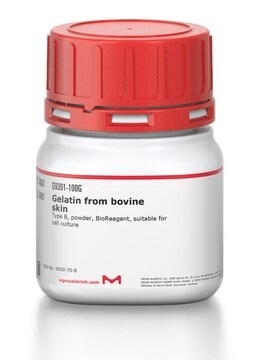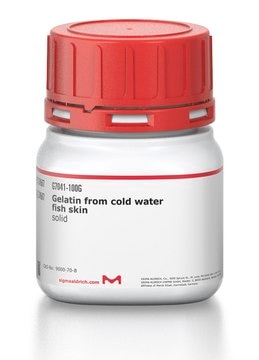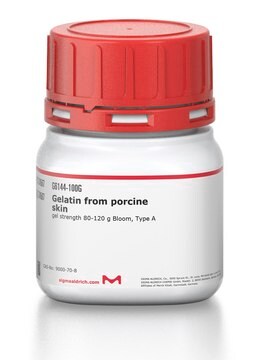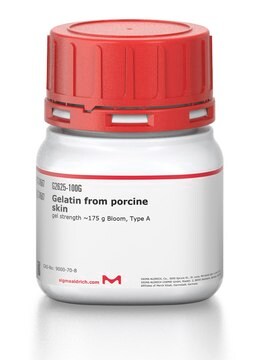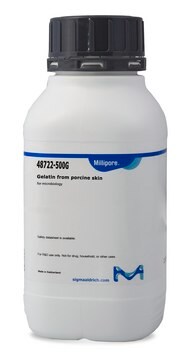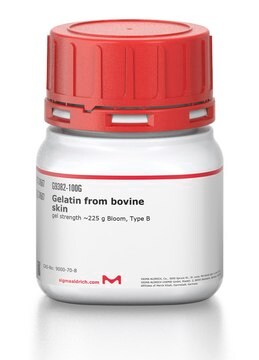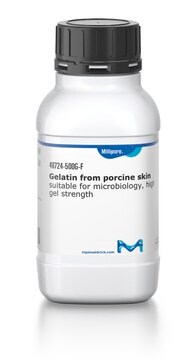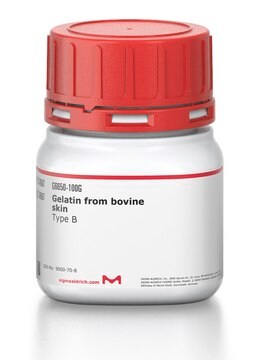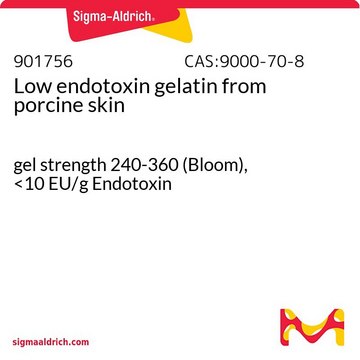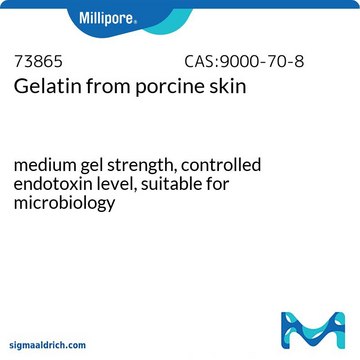Wichtige Dokumente
G1890
Porcine Gelatin
from porcine skin, Type A, powder, gel strength ~300 g Bloom, suitable for electrophoresis and cell culture
About This Item
Empfohlene Produkte
product name
Gelatine aus Schweinehaut, powder, gel strength ~300 g Bloom, Type A, BioReagent, suitable for electrophoresis, suitable for cell culture
Biologische Quelle
Porcine skin
Qualitätsniveau
Sterilität
sterile
Typ
Type A
Produktlinie
BioReagent
Form
powder
Mol-Gew.
50—100 kDa
Verpackung
pkg of 1 kg
pkg of 100 g
pkg of 500 g
Konzentration
70—90% Biuret
Methode(n)
cell culture | mammalian: suitable
electrophoresis: suitable
Oberflächendeckung
100‑200 μg/cm2
Löslichkeit
H2O: soluble 50 mg/mL, clear to hazy, faintly yellow
Versandbedingung
ambient
Lagertemp.
room temp
Suchen Sie nach ähnlichen Produkten? Aufrufen Leitfaden zum Produktvergleich
Allgemeine Beschreibung
Anwendung
Leistungsmerkmale und Vorteile
- Sterile gelatin sourced from porcine skin.
- Free from proteases.
- In the form of gelatin powder for convenient and easy handling.
- Versatile for use in cell culture and electrophoresis techniques.
- Provides adequate surface coverage for various applications.
Komponenten
Vorsicht
Angaben zur Herstellung
Lagerklassenschlüssel
11 - Combustible Solids
WGK
nwg
Flammpunkt (°F)
Not applicable
Flammpunkt (°C)
Not applicable
Persönliche Schutzausrüstung
Eyeshields, Gloves, type N95 (US)
Analysenzertifikate (COA)
Suchen Sie nach Analysenzertifikate (COA), indem Sie die Lot-/Chargennummer des Produkts eingeben. Lot- und Chargennummern sind auf dem Produktetikett hinter den Wörtern ‘Lot’ oder ‘Batch’ (Lot oder Charge) zu finden.
Besitzen Sie dieses Produkt bereits?
In der Dokumentenbibliothek finden Sie die Dokumentation zu den Produkten, die Sie kürzlich erworben haben.
Kunden haben sich ebenfalls angesehen
Artikel
Discussion of synthetic modifications to gelatin, improving the three-dimensional (3D) print resolution, and resulting material properties.
Attachment Factors for 3-Dimensional Cell Culture
The extracellular matrix (ECM) is secreted by cells and surrounds them in tissues.
We will explore the technological advances that have contributed toward the progress of 3DP of tissue engineering scaffolds, current materials used to create 3DP scaffolds, and the challenges that remain.
Unser Team von Wissenschaftlern verfügt über Erfahrung in allen Forschungsbereichen einschließlich Life Science, Materialwissenschaften, chemischer Synthese, Chromatographie, Analytik und vielen mehr..
Setzen Sie sich mit dem technischen Dienst in Verbindung.

